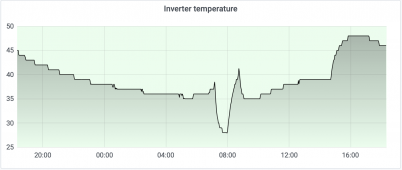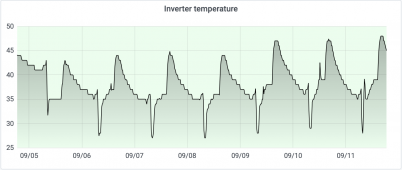Hi guys!
First time poster, long time solar/battery enthusiast
I recently finished building an offgrid system for our family cottage. Its main components are 16 200ah Lifepo4 batteries in series (with a BMS), a 48v 5kva inverter/solar charger, 660W of solar panels, a breaker panel and some 230V outlets. This is the inverter/charger: https://www.aliexpress.com/item/327...exp_id=5139b3eb-e415-4325-af92-c354b6ed039d-0
Everything works fine so far except I have a few issues with the inverter (I know, cheap & Chinese). The inverter has a power saving mode that can be activated/deactivated through settings. When it's not on power saving mode, the inverter gets quite hot on the top and I'm a little worried to leave it unattended like that. And of course it uses alot more energy too (around 55W instead of 10W on standby). On standby mode it stays pretty much at ambient temperature and even under load it doesn't get hot because the fans kick in. Several other people in my family will use the cabin as well and some of them are getting old and I want to keep the operations as simple as possible for them. About 6 years ago I also built a smaller 12VDC system, which takes care of all the LED lights and phone charging. The new 230VAC system is mainly going to be used for bigger loads such as a coffee maker, a microwave, a kettle etc. For these reasons I would like to keep the inverter ALWAYS on stand by mode.
So what's the problem? For the inverter to wake up, it needs quite a significant load. I haven't got to test it accurately yet, but I'd guess it's something like 100-200W. Even though the 12V system is good for phones/tablets/lights, my family members would like to charge their laptops, cordless drills, cameras etc. that require 230VAC.
So I thought maybe I could build a circuit, where a separate say 100-200W "dumb load" will be turned on for as long as someone needs to load their drills and whatnot. Then I thought why not use a 4amp 16S lifepo4 battery charger as a dumb load to minimize the losses and charge most of the energy back into the batteries. I tried to google this but found nobody doing it so is there something obvious that I'm missing with the idea? If I were to do this battery -> inverter -> back to battery circuit as my dumb load, what kind of safety issues should I consider?
Thanks for taking time to read my post.
First time poster, long time solar/battery enthusiast
I recently finished building an offgrid system for our family cottage. Its main components are 16 200ah Lifepo4 batteries in series (with a BMS), a 48v 5kva inverter/solar charger, 660W of solar panels, a breaker panel and some 230V outlets. This is the inverter/charger: https://www.aliexpress.com/item/327...exp_id=5139b3eb-e415-4325-af92-c354b6ed039d-0
Everything works fine so far except I have a few issues with the inverter (I know, cheap & Chinese). The inverter has a power saving mode that can be activated/deactivated through settings. When it's not on power saving mode, the inverter gets quite hot on the top and I'm a little worried to leave it unattended like that. And of course it uses alot more energy too (around 55W instead of 10W on standby). On standby mode it stays pretty much at ambient temperature and even under load it doesn't get hot because the fans kick in. Several other people in my family will use the cabin as well and some of them are getting old and I want to keep the operations as simple as possible for them. About 6 years ago I also built a smaller 12VDC system, which takes care of all the LED lights and phone charging. The new 230VAC system is mainly going to be used for bigger loads such as a coffee maker, a microwave, a kettle etc. For these reasons I would like to keep the inverter ALWAYS on stand by mode.
So what's the problem? For the inverter to wake up, it needs quite a significant load. I haven't got to test it accurately yet, but I'd guess it's something like 100-200W. Even though the 12V system is good for phones/tablets/lights, my family members would like to charge their laptops, cordless drills, cameras etc. that require 230VAC.
So I thought maybe I could build a circuit, where a separate say 100-200W "dumb load" will be turned on for as long as someone needs to load their drills and whatnot. Then I thought why not use a 4amp 16S lifepo4 battery charger as a dumb load to minimize the losses and charge most of the energy back into the batteries. I tried to google this but found nobody doing it so is there something obvious that I'm missing with the idea? If I were to do this battery -> inverter -> back to battery circuit as my dumb load, what kind of safety issues should I consider?
Thanks for taking time to read my post.





